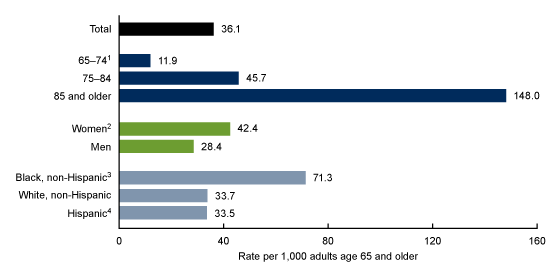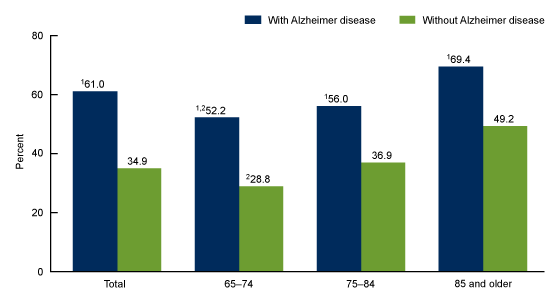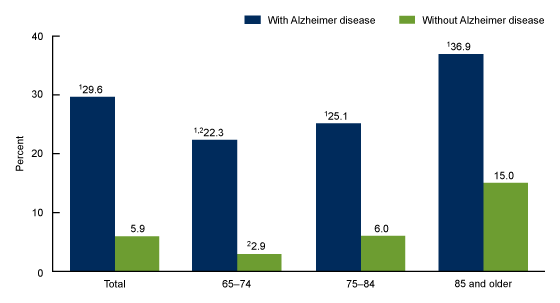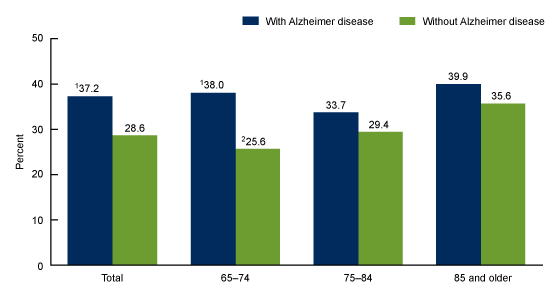Emergency Department Visits by Adults Age 65 and Older With Alzheimer Disease: United States, 2020–2022
NCHS Data Brief No. 510, October 2024
PDF Version (454 KB)
Loredana Santo, M.D., M.P.H., Susan M. Schappert, M.A., and Brian W. Ward, Ph.D.
- Key findings
- In 2020–2022, what was the emergency department visit rate among adults age 65 and older with Alzheimer disease, and did it differ by age, sex, and race and ethnicity?
- Did the percentage of ED visits made by adults age 65 and older who arrived by ambulance differ among patients with and without Alzheimer disease?
- Did the percentage of ED visits made by adults age 65 and older who live in a nursing home differ for patients with and without Alzheimer disease?
- Did the percentage of ED visits made by adults age 65 and older resulting in a hospital admission differ for those with and without Alzheimer disease?
Data from the National Hospital Ambulatory Medical Care Survey
- During 2020–2022, the annual hospital emergency department visit rate by adults age 65 and older with Alzheimer disease was 36.1 visits per 1,000 adults, and the rate increased with age.
- Ambulance arrival was more frequent for emergency department visits by adults with Alzheimer disease (61.0%) compared with visits by those without Alzheimer disease (34.9%).
- More emergency department visits were made by nursing home residents with Alzheimer disease (29.6%) compared with those without Alzheimer disease (5.9%).
- About one-third (37.2%) of emergency department visits made by adults with Alzheimer disease resulted in hospital admission compared with 28.6% of visits by adults without Alzheimer disease.
In 2022, Alzheimer disease was the seventh leading cause of death in the United States and affected an estimated 6.5 million adults age 65 and older (1–3). Adults with Alzheimer disease have been shown to rely on emergency departments (EDs) as a source for care (4,5). This report describes ED visits by adults age 65 and older with Alzheimer disease according to selected patient and visit characteristics and compares them with visits by adults without Alzheimer disease.
Keywords: dementia, National Hospital Ambulatory Medical Care Survey
In 2020–2022, what was the emergency department visit rate among adults age 65 and older with Alzheimer disease, and did it differ by age, sex, and race and ethnicity?
- In 2020–2022, the annual ED visit rate by adults age 65 and older with Alzheimer disease was 36.1 visits per 1,000 adults age 65 and older (Figure 1, Table 1).
- The ED visit rate by adults with Alzheimer disease increased with age, from 11.9 for adults ages 65–74, 45.7 for adults ages 75–84, to 148.0 for adults age 85 and older.
- The ED visit rate was higher among women (42.4 visits per 1,000 women age 65 and older) than men (28.4 visits per 1,000 men age 65 and older).
- The ED visit rate was highest among Black non-Hispanic (subsequently, Black) adults (71.3 visits per 1,000), followed by White non-Hispanic (subsequently, White; 33.7) and Hispanic (33.5) adults.
Figure 1. Emergency department visit rate for adults age 65 and older with Alzheimer disease: United States, 2020–2022

1Significant increasing trend with increasing age (p < 0.05).
2Significantly higher than men (p < 0.05).
3Significantly hi than White, non-Hispanic and Hispanic (p < 0.05).
4People of Hispanic origin may be of any race.
NOTES: Rates are based on a sample of 602 emergency department (ED) visits made by adults age 65 and older with Alzheimer disease, representing an annual average of approximately 1.99 million ED visits (6.9% of all ED visits by adults age 65 and older). Visit rates are based on sets of estimates of the U.S. civilian noninstitutionalized population, as developed by the U.S. Census Bureau, and reflect the population as of July 1 for 2020, 2021, and 2022. To be counted as an ED visit by a patient with Alzheimer disease, the “Alzheimer’s disease/Dementia” checkbox on the survey instrument had to be marked. Non-Hispanic people of other races (including American Indian and Alaska Native, Asian, Native Hawaiian or Other Pacific Islander, and people of two or more races) are included in the total rate but are not shown separately because their visit estimates do not meet National Center for Health Statistics standards of reliability. In 2020–2022, race and ethnicity were missing for 13.8% (weighted) and 16.3% (weighted) of ED visits by adults age 65 and older with Alzheimer disease; data for missing race and ethnicity were imputed.
SOURCE: National Center for Health Statistics, National Hospital Ambulatory Medical Care Survey, 2020–2022.
Did the percentage of ED visits made by adults age 65 and older who arrived by ambulance differ among patients with and without Alzheimer disease?
- The percentage of ED visits made by adults age 65 and older who arrived at the hospital by ambulance was higher for those with Alzheimer disease (61.0%) compared with those without Alzheimer disease (34.9%) (Figure 2, Table 2).
- The percentage of ED visits made by adults age 65 and older who arrived at the hospital by ambulance was higher for those with Alzheimer disease compared with those without Alzheimer disease for each age group, and it increased with age (52.2% compared with 28.8% among adults ages 65–74, 56.0% compared with 36.9% among ages 75–84, and 69.4% compared with 49.2% among those age 85 and older).
Figure 2. Percentage of emergency department visits made by adults age 65 and older with and without Alzheimer disease who arrived by ambulance, by age group: United States, 2020–2022

1Significantly higher than adults without Alzheimer disease (p < 0.05).
2Significant increasing trend with increasing age (p < 0.05).
NOTES: Percentages are based on a sample of 602 emergency department (ED) visits made by adults age 65 and older with Alzheimer disease, representing an annual average of approximately 1.99 million ED visits, and a sample of 8,582 ED visits made by adults age 65 and older without Alzheimer disease, representing an annual average of approximately 26.96 million ED visits. Data on arrival by ambulance were missing for 3.8% of ED visits made by adults age 65 and older with Alzheimer disease and 1.1% of ED visits made by adults age 65 and older without Alzheimer disease; records with missing data were excluded from the analysis. To be counted as an ED visit by a patient with Alzheimer disease, the “Alzheimer’s disease/Dementia” checkbox on the survey instrument had to be marked.
SOURCE: National Center for Health Statistics, National Hospital Ambulatory Medical Care Survey, 2020–2022.
Did the percentage of ED visits made by adults age 65 and older who live in a nursing home differ for patients with and without Alzheimer disease?
- A higher percentage of ED visits by adults age 65 and older with Alzheimer disease were made by those who live in a nursing home (29.6%) compared with those without Alzheimer disease who live in a nursing home (5.9%) (Figure 3, Table 3).
- The percentage of ED visits made by adults age 65 and older with Alzheimer disease who live in a nursing home was higher for each age group compared with those without Alzheimer disease (22.3% compared with 2.9% among adults ages 65–74, 25.1% compared with 6.0% among those ages 75–84, and 36.9% compared with 15.0% for those age 85 and older).
Figure 3. Percentage of emergency department visits made by adults age 65 and older with and without Alzheimer disease who live in a nursing home, by age group: United States, 2020–2022

1Significantly higher than adults without Alzheimer disease (p < 0.05).
2Significant increasing trend with increasing age (p < 0.05).
NOTES: Percentages are based on a sample of 602 emergency department (ED) visits made by adults age 65 and older with Alzheimer disease, representing an annual average of approximately 1.99 million ED visits, and a sample of 8,582 ED visits made by adults age 65 and older without Alzheimer disease, representing an annual average of approximately 26.96 million ED visits. Data on residence were missing for 2.1% of ED visits by adults age 65 and older with Alzheimer disease and 2.9% of ED visits by adults 65 and older without Alzheimer disease; records with missing data were excluded from the analysis. To be counted as an ED visit by a patient with Alzheimer disease, the “Alzheimer’s disease/Dementia” checkbox on the survey instrument had to be marked.
SOURCE: National Center for Health Statistics, National Hospital Ambulatory Medical Care Survey, 2020–2022.
Did the percentage of ED visits made by adults age 65 and older resulting in a hospital admission differ for those with and without Alzheimer disease?
- Among adults age 65 and older, a higher percentage of ED visits by adults with Alzheimer disease resulted in hospital admissions (37.2%) compared with visits by adults without Alzheimer disease (28.6%) (Figure 4, Table 4).
- Among adults ages 65–74, a higher percentage of ED visits by adults with Alzheimer disease resulted in hospital admissions (38.0%) compared with visits by adults without Alzheimer disease (25.6%).
- No significant difference was seen in the percentage of ED visits resulting in hospitalization by adults ages 75–84 and age 85 and older between adults with and without Alzheimer disease.
Figure 4. Percentage of emergency department visits made by adults age 65 and older with and without Alzheimer disease resulting in hospital admission, by age group: United States, 2020–2022

1Significantly higher than adults without Alzheimer disease (p < 0.05).
2Significant increasing trend with increasing age (p < 0.05).
NOTES: Percentages are based on a sample of 602 emergency department (ED) visits made by adults age 65 and older with Alzheimer disease, representing an annual average of approximately 1.99 million ED visits, and a sample of 8,582 ED visits made by adults age 65 and older without Alzheimer disease, representing an annual average of approximately 26.96 million ED visits. To be counted as an ED visit by a patient with Alzheimer disease, the “Alzheimer’s disease/Dementia” checkbox on the survey instrument had to be marked.
SOURCE: National Center for Health Statistics, National Hospital Ambulatory Medical Care Survey, 2020–2022.
Summary
In 2020–2022, the ED visit rate for adults age 65 and older with Alzheimer disease was 36.1 visits per 1,000 adults. The visit rate was higher for women than men and highest among Black adults compared with White and Hispanic adults. Among adults age 65 and older, a higher percentage of ED visits by those with Alzheimer disease were by those who lived in a nursing home compared with those without Alzheimer disease who lived in a nursing home, overall and for each age group. ED visits by adults age 65 and older with Alzheimer disease were more often the result of ambulance arrivals compared with ED visits by those without Alzheimer disease. This difference was also significant for each age group (65–74, 75–84, and 85 and older). Finally, among adults age 65 and older, a higher percentage of ED visits by adults with Alzheimer disease resulted in hospital admission. However, when examined across age groups, the difference was statistically significant only for visits by those ages 65–74.
Definitions
Arrival by ambulance: ED visits at which the patient arrived in an ambulance, either by air or ground. This includes private and public ambulances that can provide either basic or advanced life support.
ED visit rate: Calculated by dividing the number of ED visits by adults age 65 and older with Alzheimer disease by the July 1, 2020–2022, sets of estimates of the U.S. civilian noninstitutionalized population (developed by the U.S. Census Bureau’s Population Division) for each demographic group.
ED visits by adults with Alzheimer disease: Alzheimer disease diagnoses used in this analysis come from a chronic condition checkbox item on the survey instrument. The 2020, 2021, and 2022 NHAMCS asked, “Does the patient have (mark all that apply),” with a checkbox for “Alzheimer’s disease/Dementia” as one of the response options. The information for “Alzheimer’s disease/Dementia” as a checkbox item comes from two sources during NHAMCS data collection and processing. First, the checkbox may be indicated directly based on information abstracted from the medical record. Alternatively, information from up to five provider diagnoses related to the current visit, using verbatim text entries from the patient’s medical record that were later coded by National Center for Health Statistics medical coders using the International Classification of Diseases, 10th Revision, Clinical Modification (ICD–10–CM), may also be used to mark the checkbox during data processing. The ICD–10–CM codes used to mark the checkbox for “Alzheimer’s disease/Dementia” were based on the Alzheimer’s Disease and Related Disorders or Senile Dementia codes from the Centers for Medicare and Medicaid Chronic Condition Data Warehouse algorithms (6).
Hospital admission: ED visits resulting in the patient being admitted to the hospital.
Live in a nursing home: The survey instrument contains an item on patient residence. For each sampled visit, the field representative was asked to mark one of the following options: private residence, nursing home, homeless or homeless shelter, or other.
Race and ethnicity: Race and Hispanic ethnicity were collected separately, imputed, and converted into a single combined variable that includes Hispanic, Black non-Hispanic, White non-Hispanic, and other non-Hispanic races. Other races includes American Indian and Alaska Native, Asian, and Native Hawaiian or Other Pacific Islander adults, and adults of two or more races, representing 3.0% of all ED visits by adults age 65 and older with Alzheimer disease. Data for other races are included in the denominator but are not shown. For 2020–2022, 13.8% of weighted race data and 16.3% of weighted ethnicity data were missing for ED visits by adults age 65 and older with Alzheimer disease; race and ethnicity were imputed for these missing records.
Data source and methods
Data from this report are from NHAMCS, an annual, nationally representative survey of nonfederal, general, and short-stay hospitals in the United States. NHAMCS uses a multistage probability design with samples of geographic primary sampling units, hospitals within primary sampling units, and patient visits within EDs. Analyses for this report were conducted using data from restricted-use data files. Public-use versions of these files are available from:
https://www.cdc.gov/nchs/nhamcs/documentation/index.html. Count estimates and measures of variance could differ slightly between the restricted-use and public-use files. Information on accessing the restricted-use data files is available from: https://www.cdc.gov/rdc/index.htm. Additional information on the methodology of NHAMCS is available (7–9). This report presents results combining data from 2020, 2021, and 2022 for more detailed subgroup analyses.
Data analyses were performed using the statistical packages SAS version 9.4 (SAS Institute, Cary, N.C.) and SAS-callable SUDAAN version 11.0 (RTI International, Research Triangle Park, N.C.). Differences among groups were evaluated using two-sided significance tests at the p < 0.05 level. Linear regression was used to test the significance of slope for age trends. All estimates meet National Center for Health Statistics presentation standards unless otherwise noted (10).
About the authors
Loredana Santo, Susan M. Schappert, and Brian W. Ward are with the National Center for Health Statistics, Division of Health Care Statistics.
References
- Kochanek KD, Murphy SL, Xu JQ, Arias E. Mortality in the United States, 2022. NCHS Data Brief, no 492. Hyattsville, MD: National Center for Health Statistics. 2024. DOI: https://dx.doi.org/10.15620/cdc:135850.
- Alzheimer’s Association. 2022 Alzheimer’s disease facts and figures. Alzheimer Demen 18(4):700–89. 2022.
- Rajan KB, Weuve J, Barnes LL, McAninch EA, Wilson RS, Evans DA. Population estimate of people with clinical Alzheimer’s disease and mild cognitive impairment in the United States (2020–2060). Alzheimer Demen 17(12):1966–75. 2021.
- LaMantia MA, Stump TE, Messina FC, Miller DK, Callahan CM. Emergency department use among older adults with dementia. Alzheimer Dis Assoc Disord 30(1):35–40. 2016.
- Gerlach LB, Martindale J, Bynum JPW, Davis MA. Characteristics of emergency department visits among older adults with dementia. JAMA Neurol 80(9):1002–4. 2023.
- Appendix A. CMS Chronic Conditions Data Warehouse (CCW): CCW Condition Algorithms 2016.
- National Center for Health Statistics. 2020 NHAMCS micro-data file documentation. 2022.
- National Center for Health Statistics. 2021 NHAMCS micro-data file documentation. 2023.
- National Center for Health Statistics. 2022 NHAMCS micro-data file documentation. 2024.
- Parker JD, Talih M, Malec DJ, Beresovsky V, Carroll M, Gonzalez JF Jr, et al. National Center for Health Statistics data presentation standards for proportions. Vital Health Stat 2(175). 2017.
Suggested citation
Santo L, Schappert SM, Ward BW. Emergency department visits by adults age 65 and older with Alzheimer disease: United States, 2020–2022. NCHS Data Brief, no 510. Hyattsville, MD: National Center for Health Statistics. DOI: https://dx.doi.org/10.15620/cdc/164015.
Copyright information
All material appearing in this report is in the public domain and may be reproduced or copied without permission; citation as to source, however, is appreciated.
National Center for Health Statistics
Brian C. Moyer, Ph.D., Director
Amy M. Branum, Ph.D., Associate Director for Science
Division of Health Care Statistics
Carol J. DeFrances, Ph.D., Director
Alexander Strashny, Ph.D., Associate Director for Science